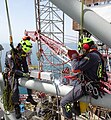Rope access
Lua error in Module:SDcat at line 26: attempt to index field 'wikibase' (a nil value).


Rope access or industrial climbing is a form of work positioning, initially developed from techniques used in climbing and caving, which applies practical ropework to allow workers to access difficult-to-reach locations without the use of scaffolding, cradles or an aerial work platform. Rope access technicians descend, ascend, and traverse ropes for access and work while suspended by their harness. Sometimes a work seat may be used. The support of the rope is intended to eliminate the likelihood of a fall altogether, but a back-up fall arrest system is used in case of the unlikely failure of the primary means of support. This redundancy system is usually achieved by using two ropes - a working line and a safety line.[1]
Trade associations such as IRATA have mandatory policies where member companies must submit all accident, incident and near miss occurrences to permit evaluation and comparison of information from an entire industry. This highlights any trends in incidents and assists in the evolution of equipment and procedures allowing continuing improvement to work practices. The above techniques along with the trade association’s organic approach has meant very few accidents since the beginning of this activity around the 1980s.[2]
ReferencesEdit
- ↑ Industrial Rope Access, Best Practices & Industry Standards, Jan Holan
- ↑ Health and Safety, IRATA.
External linksEdit
- IRATA International - Industrial Rope Access Trade Association


